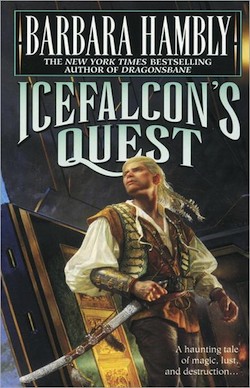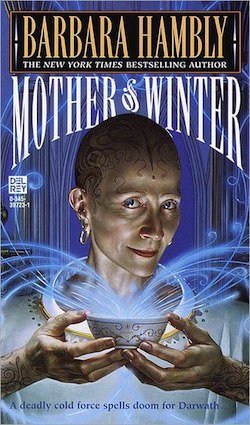Mother of Winter (1996) and Icefalcon’s Quest (1998) are two further instalments in the Darwath series. They’re essentially standalone novels, taking place some time after the events of the initial trilogy. And no, I didn’t read them as ebooks—but if it weren’t for having read the first three ebooks, I would never have been moved to track this pair down in my friendly local copyright library. (Both Mother of Winter and Icefalcon’s Quest appear to be out of print and hard to find. This saddens me, since from where I stand now, the Darwath series is quite possibly my favourite of all Hambly’s fantasies.)
Tracking them down in the library was, it turns out, an excellent decision. Mother of Winter and Icefalcon’s Quest are books from a writer at the peak of her powers.
I have complicated feelings about Mother of Winter. Gil, Rudy, Ingold and Minalde are once again the major protagonists, but—even compared to The Time of the Dark—Mother of Winter is a book full of coldness, bleakness, and desperation.
Five years after the Rising of the Dark, the world is growing colder. Hunger is a constant threat at the Keep of Dare, for crops are affected not only the weather but also by a bizarre fungus called slunch. Animals who eat the slunch are changed in strange and dangerous ways. When they start attacking wizards, Ingold and Gil set out on a perilous journey to the south, to the mountain known as the Mother of Winter and the dangerous, alien wizards beneath it who seek to remake the world in the image of the thing they guard. Meanwhile, left behind in the Keep, Rudy and Queen Minalde must deal with the business of survival: as Rudy helps Minalde and young Prince Tir investigate the secrets of the Keep’s long-forgotten past and attempts to train another young wizard, he discovers that the worst threats to their survival may not, in fact, be kept out by the Keep’s walls.
There is a lot of tension in Mother of Winter. The divisions inside the Keep and the connection between slunch and the cold; the dread of constant winter and the tensions between characters. After an attack by one of the slunch creatures, Gil finds that she cannot trust herself, for sudden irrational impulses tell her that she should kill Ingold; Rudy’s young apprentice hates him and is convinced he’s holding her back out of jealousy. Queen Minalde is pregnant and Rudy fears his skill at wizardry and medicine will not be sufficient for the birth; in the south, far from allies, Ingold and Gil must confront old adversaries as well as the frankly terrifying Mother of Winter.
Hambly evokes the constant atmosphere of cold, worry, and hunger with a deft touch. When Rudy begins to investigate the mysterious Saint Bounty and the area of the Keep known as the fifth level north, things become really creepy;
Rats and insects went scuttling, but the grating sense of being watched, of being listened for, did not lessen; the sense that something dreadful was about to happen abated not one whit… [176]
It’s this creepiness, the constant, sinister dread, that gives me mixed feelings about Mother of Winter. It’s a smart book, clever, emotionally satisfying and immensely well-written—but reading it made my stomach tie itself in knots. (From this you may gather that I have more adrenaline than is really good for me, and also that I’m not really the world’s biggest fan of acid indigestion.)
 Icefalcon’s Quest has less creepiness—or, at least, its creepiness that affected me less. It takes place two years after the events of Mother of Winter. This time neither Rudy nor Gil play the starring role: the story focuses on Prince Tir and the Icefalcon, a White Raider and probably the most deadly man in Keep of Dare, if we leave Ingold aside—Ingold Inglorion being a wizard, and thus in an entirely different category of badassery.
Icefalcon’s Quest has less creepiness—or, at least, its creepiness that affected me less. It takes place two years after the events of Mother of Winter. This time neither Rudy nor Gil play the starring role: the story focuses on Prince Tir and the Icefalcon, a White Raider and probably the most deadly man in Keep of Dare, if we leave Ingold aside—Ingold Inglorion being a wizard, and thus in an entirely different category of badassery.
When the Icefalcon rescues a pair of travelers who go on to kidnap Prince Tir, he holds himself responsible and sets out in pursuit. His journey will lead him back into the territory of White Raiders, and towards the people he left years before, including his sister, the shaman Cold Death. While Tir is being dragged north by a wizard with strange, old magic for the sake of his ancestral memories, the armies of Alketch besiege the Keep of Dare. The final confrontation takes place at an ancient, haunted Keep under the ice in the north, and is full of very agreeable quantities of fire, blood, violence and upheaval.
As the title implies, this is very much Icefalcon’s book. As his pursuit of Tir’s kidnappers leads him further north, we learn more about the White Raiders and Icefalcon’s people, the Talking Stars People: about what brought him from the “Real World” of the north, where agriculture and building are despised as extraneous to survival, and where a moment’s inattention can mean painful death, to the ‘mud-diggers’ of the civilised south before the Rising of the Dark. And Icefalcon comes to realise—if not to admit—that the south has changed him.
The White Raiders are one of the most fascinating parts of the story. Hambly sketches a complex culture, filled with complex individuals, from Icefalcon himself and his sister Cold Death, to Icefalcon’s enemy/ally Loses His Way. For the first time, we get to see the world of Darwath almost wholly from the perspective of people native to it, and it makes a pleasant change of focus. Tir is a very believable boy, albeit one whose life is complicated by the memories he’s inherited from his ancestors; the Icefalcon is—well, he’s the Icefalcon, and rather defies my ability to easily describe.
One of the things that I’ve noticed over the course of the Darwath books is how Hambly integrates magic with technology, conceptually. In a sense, the landscape of the Darwath books is doubly post-apocalyptic, because so much knowledge was lost or destroyed after the first Rising of the Dark. Magic is an integral part of development over time, historically and culturally, and it’s a seamless part of the worldbuilding. Without that already-laid foundation, the magical technology which Tir’s abductors now control—unearthed from somewhere—might seem to come a little out of nowhere. (I freely admit that the fact that the Most Annoying Character from The Time of the Dark returns yet again here annoys me, which might be affecting my judgement.)
(He’s a very believable antagonist, but Mister Ego irritates me just about as much as his real-life equivalents do. Which is a lot.)
Icefalcon’s Quest is the last of the books in the Darwath series, though there is—so I hear: I haven’t read it—“Pretty Polly,” a further short story available for purchase from Hambly’s website. While it leaves the possibility of more stories open, it remains a satisfying conclusion.
Liz Bourke is reading for a postgraduate degree in Classics from Trinity College, Dublin. In her spare time, she enjoys tea, reading, falling off walls, and the occasional martial art.










